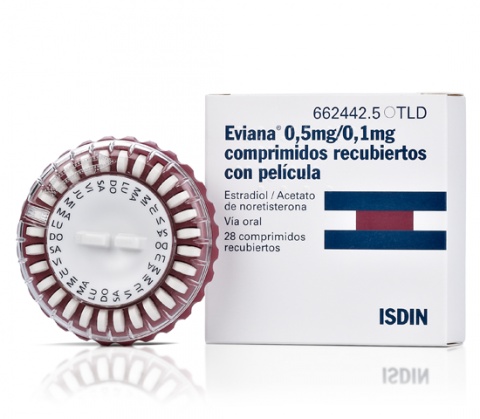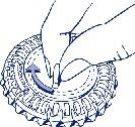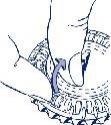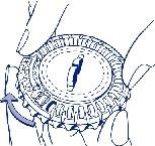

EVIANA 0.5 mg/0.1 mg FILM-COATED TABLETS


How to use EVIANA 0.5 mg/0.1 mg FILM-COATED TABLETS
Introduction
Package Leaflet: Information for the User
Eviana 0.5 mg/0.1 mg film-coated tablets
estradiol/norethisterone acetate
Read this package leaflet carefully before you start taking this medicine because it contains important information for you.
Keep this package leaflet. You may need to read it again.
- Keep this package leaflet. You may need to read it again.
- If you have any further questions, ask your doctor or pharmacist.
- This medicine has been prescribed for you only. Do not pass it on to others. It may harm them, even if their signs of illness are the same as yours.
- If you get any side effects, talk to your doctor or pharmacist. This includes any possible side effects not listed in this leaflet. See section 4.
Contents of the package leaflet
- What is Eviana and what is it used for
- What you need to know before you take Eviana
- How to take Eviana
- Possible side effects
- Storing Eviana
- Contents of the pack and other information
1. What is Eviana and what is it used for
Eviana is a continuous combined hormone replacement therapy (HRT). It contains two types of female hormones, an estrogen and a progestogen. Eviana is used in postmenopausal women who have had their last natural period at least one year ago.
Eviana is used to:
Relieve symptoms that occur after menopause
During menopause, the amount of estrogen produced by the body decreases. This can cause symptoms such as hot flashes. Eviana relieves these symptoms after menopause. Eviana will only be prescribed if your symptoms are seriously affecting your daily life.
Eviana is prescribed to women who have not had a hysterectomy and whose periods stopped more than a year ago.
Experience in treating women over 65 years old is limited.
2. What you need to know before you take Eviana
Medical history and regular check-ups
The use of HRT carries risks that need to be considered before starting or continuing treatment.
Experience in treating women with premature menopause (due to ovarian failure or surgery) is limited. If you have premature menopause, the risks of HRT may be different. Consult your doctor.
Before starting (or restarting) HRT, your doctor will ask about your medical history and that of your family. He or she may decide to perform a physical examination, which may include a breast examination or an internal examination, if necessary.
Once you have started taking Eviana, you will need to have regular check-ups (at least once a year). During these check-ups, you can discuss the benefits and risks of continuing treatment with Eviana.
Have regular breast examinations as recommended by your doctor.
Do not take Eviana
If any of the following conditions apply to you. If you are unsure about any of the following points, ask your doctorbefore taking Eviana.
Do not take Eviana:
- If you have, have had, or are suspected of having breast cancer.
- If you have, have had, or are suspected of having cancer of the lining of the uterus (endometrial cancer) or other estrogen-dependent cancer.
(cancer of the endometrium) or other estrogen-dependent cancer.
- If you have any vaginal bleeding of unknown cause.
- If you have excessive thickening of the lining of the uterus (endometrial hyperplasia) that is not being treated.
- If you have or have had blood clots in a vein (venous thromboembolism), either in the legs (deep vein thrombosis) or lungs (pulmonary embolism).
- If you have a blood clotting disorder (such as protein C, protein S, or antithrombin deficiency).
- If you have or have had a disease caused by blood clots in the arteries, such as a heart attack, stroke, or angina.
- If you have or have had liver disease and liver function tests have not returned to normal.
- If you have a rare blood disorder called porphyria, which is inherited.
- If you are allergic (hypersensitive) to estradiol, norethisterone acetate, or any of the other ingredients of Eviana (listed in section 6, "Contents of the pack and other information").
If any of these conditions occur for the first time while taking Eviana, stop taking it immediately and consult your doctor as soon as possible.
Warnings and precautions
Before starting treatment, tell your doctor if you have ever had any of the following problems, as they may return or worsen during treatment with Eviana. If so, you will need to have more frequent check-ups:
- Uterine fibroids
- Thickening of the lining of the uterus (endometriosis) or a history of excessive thickening of the lining of the uterus (endometrial hyperplasia)
- A history of blood clots (see the section "Blood clots in a vein (venous thromboembolism)")
- An increased risk of estrogen-sensitive cancer (such as having a mother, sister, or grandmother who has had breast cancer)
- High blood pressure
- A liver disorder, such as a benign liver tumor
- Diabetes
- Gallstones
- Migraine or severe headaches
- A disease that affects the immune system and various organs of the body (systemic lupus erythematosus or SLE)
- Epilepsy
- Asthma
- A disease that affects the eardrum and hearing (otosclerosis)
- A very high level of fat in the blood (triglycerides)
- Fluid retention due to heart or kidney problems
- A disorder in which the thyroid gland does not produce enough thyroid hormone (hypothyroidism), and you are being treated with thyroid hormone replacement therapy
- A hereditary disease that causes recurrent episodes of severe swelling (hereditary angioedema), or if you have had episodes of rapid swelling of the hands, face, feet, lips, tongue, throat (airway obstruction), or digestive tract (acquired angioedema)
- Lactose intolerance.
Stop taking Eviana and inform your doctor immediately
If you notice any of the following symptoms while taking HRT:
- any of the conditions listed in the "Do not take Eviana" section
- yellowing of the skin or whites of the eyes (jaundice), which can be symptoms of liver disease
- swelling of the face, lips, tongue, and/or throat, and/or difficulty swallowing or hives, along with difficulty breathing, which are symptoms of angioedema
- a significant increase in blood pressure (with symptoms such as headache, fatigue, dizziness)
- migraine-like headaches, which may occur for the first time
- if you become pregnant
- if you notice symptoms of a blood clot, such as:
- swelling with pain and redness of the legs
- sudden chest pain
- difficulty breathing
For more information, see the section "Blood clots in a vein (venous thromboembolism)".
Note:Eviana is not a contraceptive. If you are under 50 years old or it has been less than 12 months since your last menstrual period, you may still need to use a contraceptive to prevent pregnancy. Ask your doctor for advice.
HRT and cancer
Excessive thickening of the uterine lining (endometrial hyperplasia) and cancer of the uterine lining (endometrial cancer)
Estrogen-only HRT increases the risk of excessive thickening of the uterine lining (endometrial hyperplasia) and cancer of the uterine lining (endometrial cancer).
The progestogen in Eviana protects against this additional risk.
Comparison
In women aged 50-65 years with an intact uterus who are not taking HRT, about 5 cases of endometrial cancer are diagnosed per 1,000 women.
In women with an intact uterus aged 50-65 years who take estrogen-only HRT, between 10 and 60 cases of endometrial cancer are diagnosed per 1,000 users (i.e., between 5 and 55 additional cases), depending on the dose and duration of treatment.
Irregular bleeding
You may experience irregular bleeding or spotting during the first 3-6 months of taking Eviana. However, if irregular bleeding:
- persists beyond the first 6 months
- starts after you have been taking Eviana for more than 6 months
- continues after you have stopped taking Eviana
you should contact your doctor as soon as possible.
Breast cancer
Existing data show that the use of combined estrogen-progestogen HRT or estrogen-only HRT increases the risk of breast cancer. The additional risk depends on the duration of HRT use.
The additional risk becomes apparent after 3 years of use. After stopping HRT, the additional risk will decrease over time, but the risk may persist for 10 years or more if HRT has been used for more than 5 years.
Comparison
In women aged 50-54 years who are not taking HRT, about 13-17 cases of breast cancer are diagnosed per 1,000 women over a 5-year period.
In women aged 50 years who start estrogen-only HRT for 5 years, about 16-17 cases of breast cancer are diagnosed per 1,000 users (i.e., 0-3 additional cases).
In women aged 50 years who start taking combined estrogen-progestogen HRT for 5 years, about 21 cases of breast cancer are diagnosed per 1,000 users (i.e., 4-8 additional cases).
In women aged 50-59 years who are not taking HRT, about 27 cases of breast cancer are diagnosed per 1,000 women over a 10-year period.
In women aged 50 years who start estrogen-only HRT for more than 10 years, about 34 cases of breast cancer are diagnosed per 1,000 users (i.e., 7 additional cases).
In women aged 50 years who start taking combined estrogen-progestogen HRT for 10 years, about 48 cases of breast cancer are diagnosed per 1,000 users (i.e., 21 additional cases).
Examine your breasts regularly. See your doctor if you notice any changes, such as:
- dimpling of the skin
- changes in the nipples
- any lump that you can see or feel.
In addition, it is recommended to participate in breast screening programs when they are offered.
During breast screening, it is important to inform your nurse/healthcare professional that you are taking HRT when you have a mammogram, as this medication may increase breast density, which can affect the result of the mammogram. When breast density is higher, it may be that the mammogram does not detect all lumps.
Ovarian cancer
Ovarian cancer is less common than breast cancer. The use of HRT with estrogen alone or combined estrogen-progestogen has been associated with a slightly increased risk of ovarian cancer.
The risk of ovarian cancer varies with age. For example, in women aged 50-54 years who are not taking HRT, about 2 cases of ovarian cancer are diagnosed per 2,000 women over a 5-year period. In women taking HRT for 5 years, about 3 cases are diagnosed per 2,000 patients (i.e., about 1 additional case).
Effect of HRT on the heart and circulation
Blood clots in a vein (venous thromboembolism)
The risk of blood clots in the veins is approximately 1.3 to 3 times higher in HRT users than in non-users, especially during the first year.
Blood clots can be serious, and if one reaches the lungs, it can cause chest pain, difficulty breathing, fainting, or even death.
The likelihood of having a blood clot in the veins will be higher with increasing age and if any of the following factors apply to you. If any of these situations may apply to you, inform your doctor:
- you will be unable to walk for a long time due to a major operation, injury, or illness (see also section 3, "If you need to have surgery")
- you are significantly overweight (BMI > 30 kg/m2)
- you have a blood clotting disorder that requires long-term treatment with medication to prevent clots
- a close relative has had a blood clot in the legs, lungs, or other organs
- you have systemic lupus erythematosus (SLE)
- you have cancer.
To learn about the symptoms caused by a blood clot, see the section "Stop taking Eviana and inform your doctor immediately".
Comparison
It is estimated that, over a 5-year period, about 4-7 cases of blood clots in the veins will occur per 1,000 women in their 50s who are not taking HRT.
In women in their 50s who take combined estrogen-progestogen HRT for 5 years, about 9-12 cases will occur per 1,000 users (i.e., 5 additional cases).
Heart disease (myocardial infarction)
HRT has not been shown to prevent myocardial infarction. Women over 60 years old who use combined estrogen-progestogen HRT have a slightly higher risk of developing heart disease than those who do not take HRT.
Stroke
The risk of stroke is approximately 1.5 times higher in HRT users than in non-users. The number of additional stroke cases due to HRT use will increase with age.
Comparison
It is estimated that, over a 5-year period, about 8 cases of stroke will occur per 1,000 women in their 50s who are not taking HRT.
In women in their 50s who are taking HRT, the number of cases will be about 11 per 1,000 users over a 5-year period (i.e., 3 additional cases).
Other disorders
HRT does not prevent memory loss. There is evidence of a higher risk of memory loss in women who start HRT after the age of 65. Ask your doctor for advice.
Using Eviana with other medicines
Some medicines may interfere with the effect of Eviana. This may cause irregular bleeding.
Such medicines are:
- Medicines for epilepsy (such as phenobarbital, phenytoin, and carbamazepine)
- Medicines for tuberculosis (such as rifampicin and rifabutin)
- Medicines for HIV infection (such as nevirapine, efavirenz, ritonavir, and nelfinavir)
- Medicines for hepatitis C (such as telaprevir)
- Preparations containing St. John's Wort (Hypericum perforatum).
HRT may affect the performance of certain medicines:
- Medicine for epilepsy (lamotrigine), as it may increase the frequency of seizures.
- Medicines for hepatitis C (such as the combination of ombitasvir/paritaprevir/ritonavir with or without dasabuvir, as well as a regimen with glecaprevir/pibrentasvir) may cause increases in liver function test results (increase in liver enzyme ALT) in women using combined hormonal contraceptives (CHC) that contain ethinylestradiol. Eviana contains estradiol instead of ethinylestradiol. It is not known whether an increase in liver enzyme ALT may occur when using Eviana with this hepatitis C regimen.
Other medicines may increase the effects of Eviana:
- Medicines containing ketoconazole (an antifungal).
Eviana may affect treatment with concomitant cyclosporine.
Tell your doctor or pharmacistif you are taking or have recently taken any other medicines, including those obtained without a prescription, herbal medicines, or other natural products. Your doctor will advise you.
Lab tests
If you need to have a blood test, inform your doctor or laboratory staff that you are taking Eviana, as this medicine may affect the results of some laboratory tests.
Taking Eviana with other medicines and drinks
The tablets can be taken with or without food or drink.
Pregnancy and breastfeeding
Pregnancy:Eviana should only be used in postmenopausal women. If you become pregnant, stop taking Eviana and contact your doctor.
Breastfeeding:You should not take Eviana if you are breastfeeding.
Driving and using machines
Eviana has no known effects on the ability to drive or use machines.
Important information about some of the ingredients of Eviana:
Eviana contains lactose monohydrate. If you have an intolerance to certain sugars, consult your doctor before taking this medicine.
3. How to take Eviana
Follow exactly the administration instructions of this medication indicated by your doctor.
In case of doubt, consult your doctor or pharmacist.
Take one tablet once a day, approximately at the same time every day.Take the tablet with a glass of water.
Take one tablet every day without interruption.After taking the 28 tablets from the disk-calendar package, you should continue with a new one.
For more information about using the calendar package, see USER INSTRUCTIONS at the end of this prospectus.
You can start treatment with Evianaany day of the week. However, if you have changed from another THS product with which you had menstrual bleeding, start the new treatment right after the bleeding has finished.
Your doctor should prescribe the lowest effective dose for the shortest possible time that provides relief from symptoms. Talk to your doctor if you think the dose is excessive or insufficient.
If you take more Eviana than you should
If you have taken more Eviana than you should, consult your doctor or pharmacist as soon as possible. Taking more estrogen than prescribed by your doctor can cause breast tenderness, nausea, vomiting, and/or irregular vaginal bleeding (metrorrhagia). Taking more progestogen than prescribed by your doctor can cause depressive mood, fatigue, acne, and excessive growth of body or facial hair (hirsutism).
If you forget to take Eviana
If you have forgotten to take the corresponding tablet at the usual time, take it within the next 12 hours. If more than 12 hours have passed, take it the next day at the usual time. Do not take a double dose to make up for the forgotten dose.
Forgetting a dose may increase the likelihood of experiencing intercurrent bleeding and spotting, unless you have had a hysterectomy.
If you interrupt treatment with Eviana
If you want to interrupt treatment with Eviana, talk to your doctor first, who will explain the effects of interrupting treatment and discuss other possibilities with you.
If you have any other doubts about the use of this medication, ask your doctor or pharmacist.
If you are going to have surgery
If you are going to have surgery, inform the surgeon that you are taking Eviana. You may need to stop taking Eviana 4 to 6 weeks before the operation to reduce the risk of blood clots (see the section "Blood clots in a vein (venous thromboembolism)" in section 2). Ask your doctor when you can start taking Eviana again.
4. Possible side effects
Like all medications, this medication can cause side effects, although not everyone experiences them.
The following disorders have been reported more frequently in women using THS compared to those who do not use it:
- breast cancer
- abnormal growth or cancer of the uterine lining (endometrial hyperplasia or endometrial cancer)
- ovarian cancer
- blood clots in the veins of the legs or lungs (venous thromboembolism)
- heart disease
- stroke
- possible memory loss if THS is started after 65 years of age.
For more information on these side effects, see section 2, "What you need to know before taking Eviana".
Very common side effects (may affect more than 1 in 10 people)
- Vaginal bleeding.
Common side effects (may affect up to 1 in 10 people)
- Fungal infection in the genitals or vaginal inflammation
- Excessive growth of the uterine lining (endometrial hyperplasia)
- Nausea
- Abdominal pain (stomach)
- Back or neck pain
- Pain in the arms or legs
- Headache.
Uncommon side effects (may affect up to 1 in 100 people)
- Allergic reactions (hypersensitivity)
- Depression or worsening of existing depression
- Nervousness
- Dizziness
- Migraines (see the section "Interrupting treatment with Eviana" in section 2)
- Breast pain or discomfort
- Abdominal inflammation or distension (stomach)
- Weight gain due to fluid retention
- Swelling of arms and legs (peripheral edema)
- Leg cramps
- Acidity (dyspepsia)
- Acne
- Hair loss (alopecia)
- Itching or hives.
Very rare side effects (may affect up to 1 in 10,000 people)
- Generalized hypersensitivity reactions (e.g., anaphylactic reaction or anaphylactic shock) have been reported.
Other side effects of combined THS
- Gallbladder disease
- Various skin disorders:
- skin pigmentation, especially on the face and neck, known as "pregnancy spots" (chloasma)
- red and painful skin nodules (erythema nodosum)
- eruption with ulcers or redness in a target shape (erythema multiforme)
- red or purple discoloration of the skin and/or mucous membranes (vascular purpura)
- Dry eyes
- Changes in tear composition.
Reporting side effects
If you experience any side effects, consult your doctor or pharmacist, even if they are possible side effects that do not appear in this prospectus. You can also report them directly through the Spanish Pharmacovigilance System for Human Use Medicines: https://www.notificaram.es. By reporting side effects, you can contribute to providing more information on the safety of this medication.
5. Storage of Eviana
Keep this medication out of sight and reach of children.
Do not use this medication after the expiration date that appears on the label and on the outer packaging, after "EXP". The expiration date is the last day of the month indicated.
Do not store at a temperature above 25 °C. Do not refrigerate.
Keep the package in the outer packaging to protect it from light.
Medicines should not be thrown down the drain or into the trash. Ask your pharmacist how to dispose of packages and medicines that are no longer needed. This will help protect the environment.
6. Package contents and additional information
Composition of Eviana
- The active ingredients of Eviana are estradiol and norethisterone acetate. Each tablet contains 0.5 mg of estradiol (as estradiol hemihydrate) and 0.1 mg of norethisterone acetate.
- The other components are: lactose monohydrate, cornstarch, hydroxypropyl cellulose, magnesium stearate, hypromellose, triacetin, and talc.
Appearance of the product and package contents
Coated tablets, white, round, with a diameter of 6 mm. On one side, it is engraved "NOVO 291" and on the other, the Novo-Nordisk logo (an Apis bull).
Presentation:
- 28 film-coated tablets
- 3 x 28 film-coated tablets
Only some package sizes may be marketed.
Marketing authorization holder and manufacturer
Holder:
Isdin S.A.
Provençals 33
Barcelona 08019
Spain
Manufacturer:
Novo Nordisk A/S
Novo Allé
DK-2880 Bagsværd
Denmark
This medication is authorized in the Member States of the European Economic Area under the following names:
Activelle: Austria, Portugal
Activelle low: Denmark, Iceland, Italy
Activelle minor: Belgium, Luxembourg
Eviana: Estonia, Hungary, Netherlands, Norway, Spain, Sweden
Noviana: Finland
Date of the last revision of this prospectus:September 2024
Other sources of information
Detailed information about this medication is available on the website of {name of Member State/Agency}:
INSTRUCTIONS FOR THE USER
How to use the disk-calendar package
- Place the day indicator
Turn the inner disk and fix the day of the week in front of the closed opening with a plastic tab.

- How to extract the first tablet
Break the plastic tab and extract the first tablet.


- Move the dial every day
Simply turn the transparent disk 1 space in the direction of the clock hands, as indicated by the arrow. Extract the next tablet. Remember to take only 1 tablet per day.
The transparent disk can only be turned once the corresponding tablet has been extracted.

- Country of registration
- Active substance
- Prescription requiredYes
- Manufacturer
- CompositionLACTOSA MONOHIDRATO (37.5 mg mg)
- This information is for reference only and does not constitute medical advice. Always consult a licensed doctor before taking any medication. Oladoctor is not responsible for medical decisions based on this content.
- Alternatives to EVIANA 0.5 mg/0.1 mg FILM-COATED TABLETSDosage form: TABLET, 1 mg / 0.5 mgActive substance: norethisterone and estrogenManufacturer: Isdin S.A.Prescription requiredDosage form: TABLET, 1/2 mg/mgManufacturer: Bayer Hispania S.L.Prescription requiredDosage form: CAPSULE, 1 mg / 100 mgActive substance: progesterone and estrogenManufacturer: Theramex Ireland LimitedPrescription required




